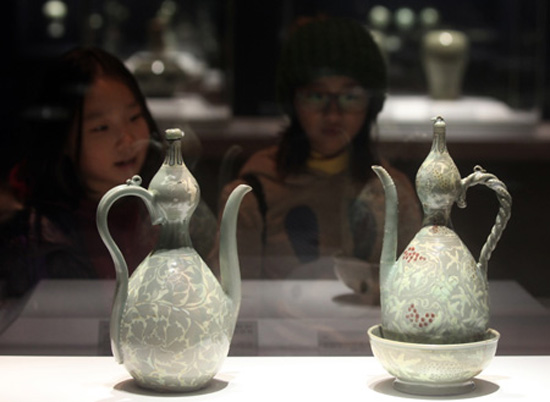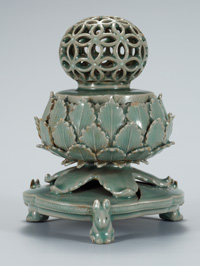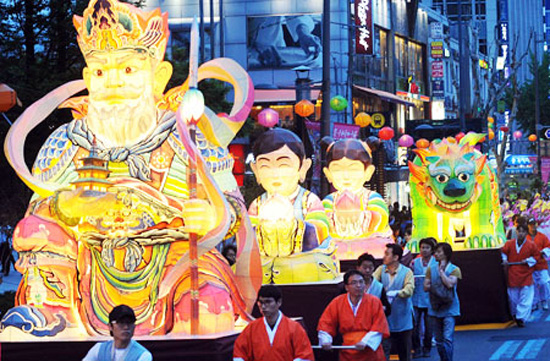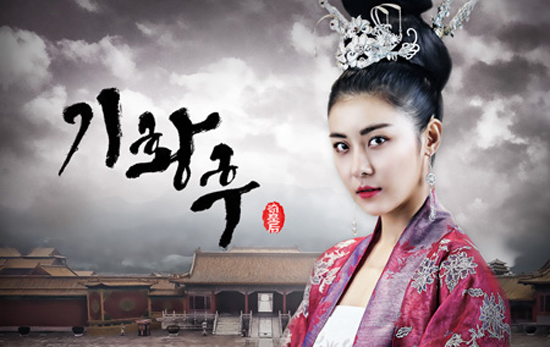- California Assembly OKs highest minimum wage in nation
- S. Korea unveils first graphic cigarette warnings
- US joins with South Korea, Japan in bid to deter North Korea
- LPGA golfer Chun In-gee finally back in action
- S. Korea won’t be top seed in final World Cup qualification round
- US men’s soccer misses 2nd straight Olympics
- US back on track in qualifying with 4-0 win over Guatemala
- High-intensity workout injuries spawn cottage industry
- CDC expands range of Zika mosquitoes into parts of Northeast
- Who knew? ‘The Walking Dead’ is helping families connect
Color of jade
National museum’s expanded Goryeo celadon hall is worth visiting

Visitors look at artifacts displayed at the National Museum of Korea’s Goryeo celadon exhibition hall, which reopened on Tuesday after a year of renovations. (Yonhap)
By Baek Byung-yeul
The exquisite, gray-green hue of medieval Goryeo celadon has been claimed by many as the most beautiful element of Korean culture. After walking through the National Museum of Korea’s (NMK) renovated celadon exhibition hall, it becomes difficult to argue with that belief.
It was precisely a year ago when the museum in Yongsan, central Seoul, temporary closed what has always been one of its most popular display spaces to give it a modern layout and increase the number of items featured. The end result, which was revealed to the public on Tuesday, is decidedly impressive.
The number of artifacts displayed at the hall increased from 60 to 160, highlighted by the addition of 11 national treasures and other state-protected assets.
But the star of the collection remains a mainstay: the “Celadon Openwork Incense Burner,” a 12th century work designated as National Treasure No. 95, distinctive for its elegant glaze and sophisticated inlay patterns.
Another masterpiece is the “Celadon Incense Burner with Lion-shaped Lid,” designated as National Treasure No. 60. It’s an artifact that even appears in a 12th century document, where a Chinese envoy from the Song Dynasty (960-1279) praises it for its color and shape.
“We wanted to break entirely from the form of the previous exhibition hall and start anew. The old hall was unimaginative as a display space, where celadon and other artifacts were just placed there with their name tags,” said Jang Sung-wook, a curator at the museum.
“What we wanted to do was to effectively deliver the two key elements that differentiate Goryeo celadon — the jade-green color and the detailed inlay patterns, produced through the traditional ‘sanggam’ technique.
“The new addictions to the display were items that had been protected in our storage. We wanted to expand the exhibition. We believe that every piece of Goryeo celadon that was pictured in the school textbooks is now displayed. These items are displayed with other everyday items such as rice bowls and dishes to improve the understanding of how they were used by people in the Goryeo Kingdom (918-1392) period.”
The significant items of the collection are now more visible because they are displayed in independent glass cases. The hall has also become a friendlier space for international visitors with descriptions of each item provided in English and other foreign languages.
Jang added, “Lighting was a delicate part of the process. Every lamp has been adjusted in a way so that they best represent the color and shape of the item in display.”
“Although celadon came to Korea from China, records show that Chinese people of that time praised that it was the masters from Goryeo who perfected celadon as an art. We hope that the renewed exhibition hall will represent these artifacts in an ideal way and become a must-see space of the museum.”
The exhibition hall is located on the third floor of the museum, which is a short walk out from Ichon Station on subway line 4. Admission is free. For more information, call (02) 2077-9000 or visit www.museum.go.kr.















